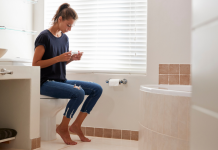The old adage goes that only a few things in life are for certain: death and taxes. I’d like to add the following to that list: the toddler with the sniffles will decide to share my child’s sippy cup.
Tis the season for germs. Colds, flu and bugs of all sorts and kinds start traveling around as the weather gets colder. For us moms that brings a seasonal joy like no other.
 I’m writing this post just a few hours after being vomited on. Yes, that’s right – a full blown, stomach-emptying “yak” all over me (and our sofa). Fun, hnh? Even the common cold can be a pretty gross experience for the average mom (it does get a little better when they can finally blow their own noses).
I’m writing this post just a few hours after being vomited on. Yes, that’s right – a full blown, stomach-emptying “yak” all over me (and our sofa). Fun, hnh? Even the common cold can be a pretty gross experience for the average mom (it does get a little better when they can finally blow their own noses).
So, what can we do? As much as I try to follow them around with a bottle of hand sanitizer, my kids still seem to pick stuff up. I’ve considered investing in bubble suits, but my husband thinks this might cause them psychological issues.
Alas, I’m forced to find other, more affordable solutions to try to battle the germs that are seemingly determined to get us. Here are a few ideas that I use to try to keep sickness away and to help things go better when it’s already gotten us!
*I’m not a doctor and have no degree in anything close to nursing. Accordingly, please consult with your pediatrician if you have any questions or wonder if these suggestions are right for your family.
1. Do vitamins in the morning. I frequent the site: www.askdrsears.com and he suggests loading your children up with vitamins c and d before they head off to germville (school, daycare, playgrounds, etc…). He suggests feeding them fruit (or making a smoothie) to utilize the best natural food sources of these vitamins.
I try to do fruit in the morning (especially anti-oxidant rich berries) and I recently started doing vitamins in the morning (as opposed to at dinner) based on his suggestion. I think it’s helping. I try to focus on Vitamin D – it’s a big immune system booster. I have gummy vitamins for my “big” kids and drops for the baby (you can put it on you if breastfeeding or drop it on the top of a bottle or sippy cup). New studies show most people (including kids) are woefully low on vitamin D. My kids also take probiotics and omega-3s.
2. Buy a temporal thermometer. A what? It’s the one that you simply run across a forehead and get a very accurate reading. We had an ear thermometer but it’s hard to get a sick child to stay still for that long. And, truly, who wants to do a rectal temperature reading? Trust me, it’ll be a good investment.
3. Get out your beach towels. They are softer than the average bath towel and make great “bed liners” if you think there is a chance your child might throw up in bed. Kid’s beach towels are about the same size as a crib mattress. It’s much easier to peel off a towel (or two) after a vomiting episode than it is to try to change a crib sheet (especially in the middle of the night while holding a crying and sick child). I also suggest putting one beside the crib because most standing babies will make it to their feet before throwing up.
4. Have liquid assets. In my pantry you will always find the following: Gatorade (unless my husband drinks it), Jell-o, and Pedialyte. I also keep those freez pops (you know the long stick ones that you buy not frozen). Kids get dehydrated so quickly when they are sick. Some kids will refuse to eat or drink anything at all when they don’t feel well. So, do whatever it takes to get liquid into them. Jell-o mixed with water (but not set), is a great, calorie laden, juice substitute for an emergency. I also try to keep white grape juice. It is the lowest sugar of all the juices and easiest on an upset stomach. When your child is sick, keeping them hydrated normally means using something other than water so that they get some calories, electrolytes, and sugar.
5. Keep meds on hand, but don’t rush for them. Doctors (and studies) are now showing that low-grade fevers (under 101 in a child over 1) do not usually require treatment. In some cases, it is actually good for your child’s immune system to fight the fever. Ask your doctor at what temperature you should administer infant or children’s Tylenol or motrin. Also—watch out for new dosing information on children’s Tylenol. They are changing the strength of the medication so read carefully if you buy a new bottle.
Hope these tips help you stay well this winter! What strategies do you use to try to keep your kids healthy?













